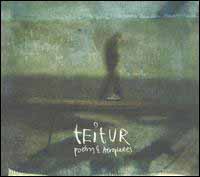|

Teitur:
Island Songs
story by tim mcmahan
| |
|
Lazy-i: May 19, 2004
|
Teitur
w/Griffin House
Tuesday, May 25
The Ranch Bowl
1600 S. 72nd St.
$8
9 p.m.
| |
|
On first listen, you might think you've heard laid-back pop-singer
Teitur's music before. His style is a throwback to a simpler time,
before American Idols and hip-hop razzamatazz, back when words and music and melody
ruled the radio waves. The profound influence of '70s AM singer-songwriters might
have something to do with where he grew up. Teitur's homeland, the Faroe
Islands, lies northwest of Scotland and halfway between Iceland and Norway. Part
of the Kingdom of Denmark, the islands' 48,000 inhabitants, most of whom make
their living from the fishing industry, speak Faroese, an ancient language rooted
in Old Norse. Pictures of the Faroes on the Internet make it look like a storybook
land of steep jagged cliffs and sod-roofed stone houses that conjure up visions
of hobbits and wizards.
|
| |
"It's a very small community, and music is
very much a part of people's lives," said Teitur as he navigated the Interstate
somewhere between Pittsburgh and Cleveland in a land that must seem a million
miles away from his native soil. "Living there is probably like living in
any small town in America, but without a chance to drive four hours to see the
latest band." With only one radio station on the islands, Teitur grew
up listening to Western pop standards. "Obviously I didn't get a chance to
hear eclectic records or develop an interest in a certain performer or style of
music, or see cool rock bands. All I had was what was on the radio." But
that was enough to inspire him to take on a career as a musician and songwriter
with a style influenced by artists as diverse as The Beatles, Gershwin, Burt Bacharach,
Joan Armatrading and Joni Mitchell. "I didn't write Faroes music," he
said, explaining that all of his songwriting is in English. "I listened to
some Faroes songs of course, but there's not much Faroes in my stuff. It's no
different than how bands from Sweden and Norway write Western-influenced music." With
his old-school singer-songwriter roots, it only made sense that Teitur's first
album would be produced by one of pop music's more successful hitmakers, Rupert
Hine, who has worked with everyone from Tina Turner (Private Dancer) to
Stevie Nicks (Other Side of the Mirror) to Suzanne Vega (Songs in Red
and Gray). Teitur said Hines first heard his music through his music
publisher, and afterward approached him to work on the project. "We really
clicked when we first met," Teitur said. "The process of working with
someone to find the essence of what you're trying to accomplish is hard work,
and someone like Rupert got me there."
| 
|
"Obviously
I didn't get a chance to hear eclectic records... All I had was what was on the
radio."
| |
|
| |
"Every
city might be new, but there very seldom is an element of surprise."
| | | The
result was Teitur's debut full-length, Poetry & Aeroplanes, recently
released on Universal. The New York Times said the CD "evokes the
reveries of a romantic troubadour musing out loud as he travels the world."
Pure hogwash. Teitur's music is much more grounded than that. Its smooth, sentimental
pop harkens to '70s-era Simon and Garfunkel or Up on the Roof-flavored James Taylor,
quietly dominated by Teitur's intricate acoustic guitar work and his sweet, warm
voice that closely resembles Simon's. After being on the road for a year
and playing nearly 200 dates in Europe and the United States, Teitur says his
travels are influencing his songwriting. "I wrote a song today about how
you can be the same person wherever you are," he said. "I'm thinking
a lot about that these days, how no matter where you go, everyone is just the
same and you can give and take only what you have. "Every city might
be new," Teitur said, "but there very seldom is an element of surprise.
People are pretty much the same wherever you are."
Back
to  Published
in The Omaha Reader May 19, 2004. Copyright © 2004 Tim McMahan. All rights reserved.
| | |
| | | |
